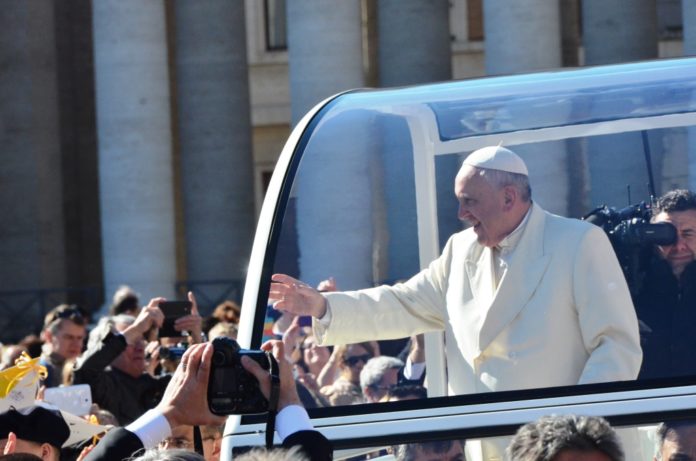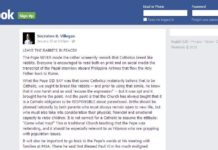The “Mass of Mercy and Compassion” at Luneta Park to be offered by Pope Francis will be “multilingual,” with a number of parts using the country’s seven major dialects aside from English, papal visit organizers said.
“The aim is to create a national consciousness of unity despite diverse cultural expressions and to foster a sense of unity with the universal Church,” said Fr. Genaro Diwa, liturgical affairs head of the Archdiocese of Manila and in-charge of liturgical preparations for the Closing Mass of the Papal Visit on Sunday, Jan. 18.
Fr. Diwa said the text of the Mass of Mercy and Compassion would be based on the New English Translation of the Third Edition of the Roman Missal (in effect starting 2011 in much the English-speaking world) and the approved translations of the Order of the Mass in seven major Philippine languages. The text will also “predominantly” employ Tagalog, Sugbuanon (Cebuano), and Ilocano; with selected verses in Bicol, Capampangan, Hiligaynon (Ilongo) and Waray, as well as in English, Latin, and Spanish. Missalettes will be provided.
Readers in the Luneta Mass will be from various walks of life including a blind person and one from the youth. The prayers of the faithful will be read in the seven major Philippine languages by representatives of the urban poor, religious, youth, professionals, and government. There will be no commentator as preferred by the Vatican.
“Because of the many languages incorporated, an antiphonal-mode has been adopted. The simple and singable multilingual refrains or choruses are to be sung by the entire congregation, while the more complex verses in various languages are to be sung by a cantor or the choir,” Fr. Diwa explained.
“Musically, this multilingual Mass-setting fuses both Western music and Filipino indigenous rhythms, such as the Kalinga rhythm from the north and the Singkil rhythm from the south, and Filipino melodic and chord patterns, such as the Kundiman of Central Luzon,” he added.
Singing will be led by a 1,000-voice choir from Manila, Cubao, Pasig, Novaliches, Kalookan, Antipolo, San Pablo, Parañaque, Malolos, and Batangas with a 100-member orchestra from the Conservatory of Music of the University of Santo Tomas and other Catholic schools. The Luneta Mass songs were composed by Fr. Manuel “Manoling” Francisco, S.J.
The song “We Are All God’s Children” will be sung after the communion while the 1995 World Youth Day song “Tell the World of His Love” will be the final song. The 2015 Papal Visit also marks the 20th anniversary of the 10th World Youth Day celebrations led by Pope St. John Paul II in Manila. The concluding Mass of the 1995 papal visit, held at Luneta (also called Rizal Park) was said to have drawn a crowd of five million.
‘Sinulog’ welcome
Fr. Rufino Sescon, chancellor of the Archdiocese of Manila, noted that the “simple and elegant” Luneta mass would coincide with the Feast of Sto. Niño, which celebrates the popular devotion to the image of the Child Jesus first brought by Spanish missionaries in 1521.
The Cebu-based Sandiego Dance Company has been invited to perform the traditional Sinulog dance as a “welcome gesture” while the Supreme Pontiff is making his way to the Quirino Grandstand in Luneta.
“We will welcome the Pope by a Sinulog dance as he goes around the Rizal Park blessing the people. We will [ask] them to bring the images of the Sto. Niño so that when the Pope is going around, they [will] carry the Sto. Niño,” Fr. Sescon, who is also the chaplain of Sto. Niño de Paz Chapel in Greenbelt, Makati, said.
Fr. Sescon said the presumptive theme of the homily of the 78-year-old Pope Francis would be about the Papal Visit theme “Mercy and Compassion” and the Feast of Sto. Niño. “We presume that because it will be the liturgy of the Sto. Niño [and] he will take off from that spirit [of] being child-like for the kingdom of God. [The Pope] may fuse these two themes: the Sto. Niño and the mercy and compassion,” Fr. Sescon said.
“Being the concluding Mass, [it will] sum up everything that transpired. The Holy Father [will] give a message to the nation [because] that is the moment and perfect opportunity and that it is really the only Mass in Manila [open] to the public.”
Fr. Diwa said the Pope’s chasuble or liturgical vestment in Luneta would be Philippine-made, with images of the Sto. Niño.
‘Orante-inspired’
Robert Cruz, owner of VitreArtus, a Laguna-based maker of liturgical arts and furniture, was commissioned to produce the liturgical furnishings made of Philippine mahogany for the Luneta rites.
The papal chair in Luneta will be engraved with the papal coat of arms as well as wooden carvings of the Anahaw leaf, giving it a “Filipino flavor.” It will also have a small shepherd carving with words “Ang Mabuting Pastol” (The Good Shepherd) on top of the seat’s backrest, in line with the “Mercy and Compassion” theme.
Fr. Diwa said the “orante”-inspired altar table, taking the image of hands lifted up in prayer and offering, won’t have gold leafings but the table would be ornamented with an anahaw-inspired base and alternating designs of cross and dove that symbolize the Church’s mission.
VitreArtus is set to create more than 30 pieces of liturgical furniture, including seven candelabras, a five-foot lectern, and 11 chairs for the bishops concelebrating with Pope Francis.
The color copper will be used in the altar, Fr. Diwa said. The reddish-orange hue “suggests a transition metal with high thermal and electrical property. This color is used as accent to suggest the ‘warmth’ of the Gospel message and the ‘conductibility’ of faith, meaning faith as the greatest heritage of humanity for all generations,” he said.
He added: “The lectern or ambo follows the same motif as the altar table giving it, the Liturgy of the Word, the same weight as the Liturgy of the Eucharist. The rosette being four in number, represents the Evangelists.” Jerome P. Villanueva











